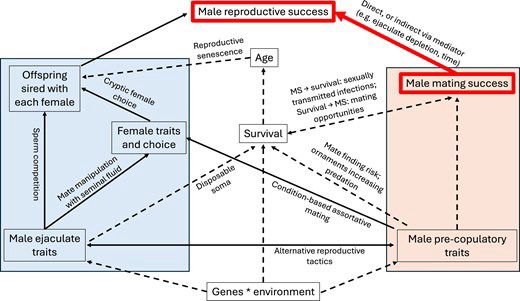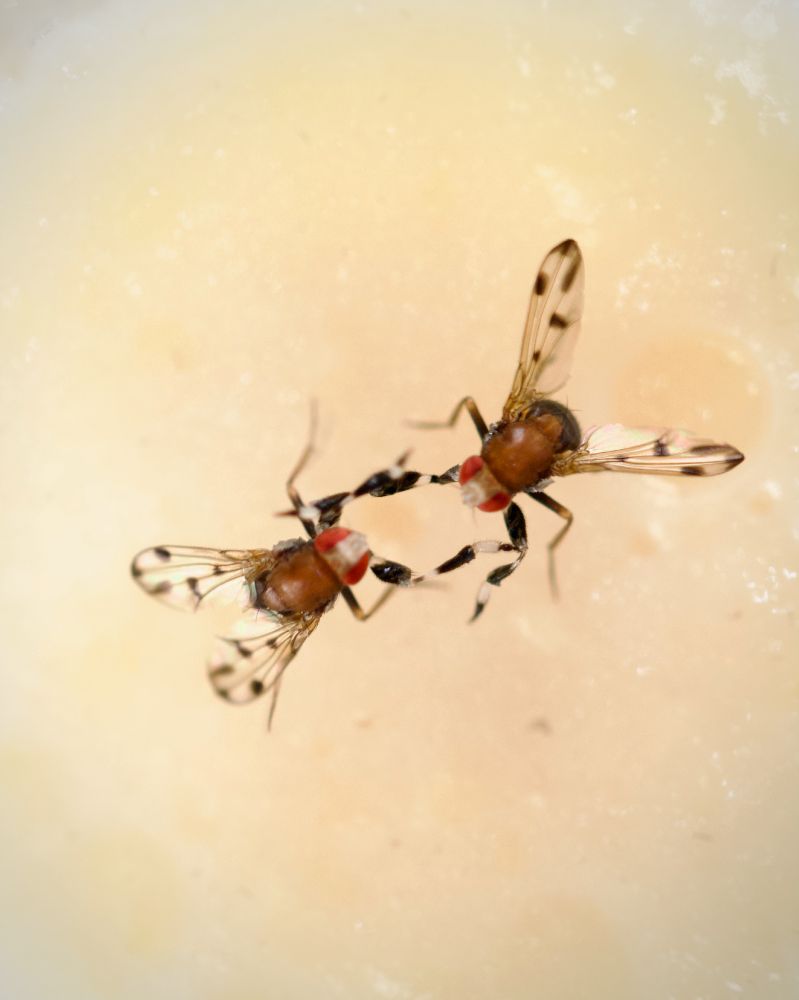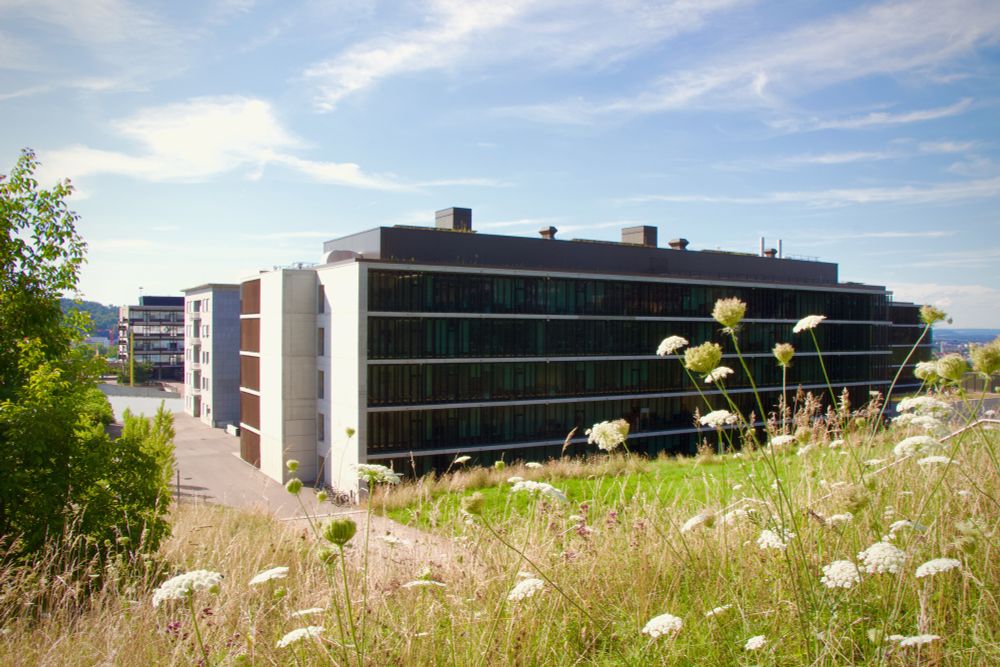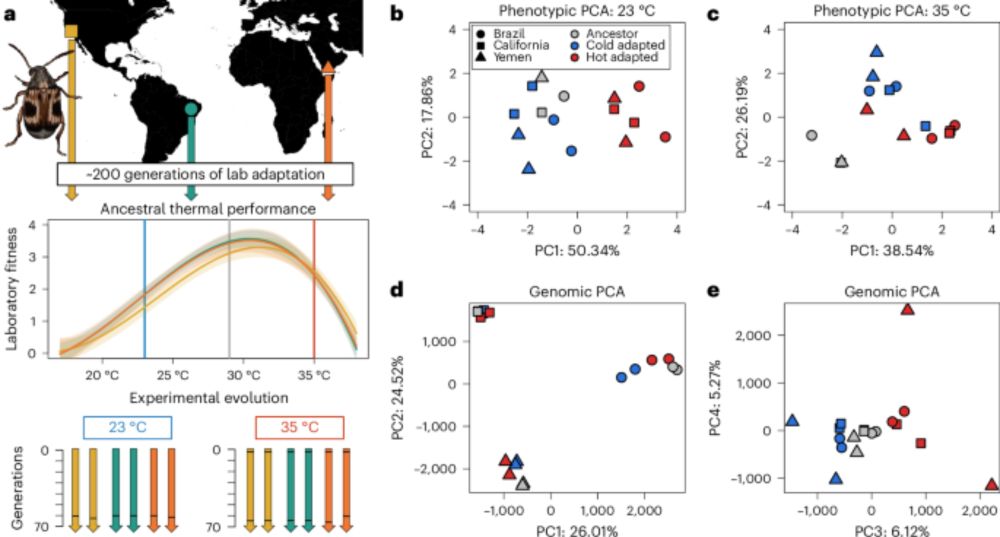Tim Janicke
@timjanicke.bsky.social
Evolutionary biology | Behavioural ecology | Sexual selection
@CNRS, CEFE, Montpellier
@CNRS, CEFE, Montpellier
Reposted by Tim Janicke
In a stunning display of coordinated movement, male Swallow-tailed Manakins dance together in groups of up to five to attract females. Researchers studied display consistency, group size effects and implications for female choice: royalsocietypublishing.org/doi/10.1098/... #RSOS #AnimalBehaviour

November 9, 2025 at 10:00 AM
In a stunning display of coordinated movement, male Swallow-tailed Manakins dance together in groups of up to five to attract females. Researchers studied display consistency, group size effects and implications for female choice: royalsocietypublishing.org/doi/10.1098/... #RSOS #AnimalBehaviour
Reposted by Tim Janicke
Fast females, slow males: accelerated ageing and reproductive senescence in Drosophila melanogaster females across diverse social environments url: academic.oup.com/evlett/artic...

Fast females, slow males: accelerated ageing and reproductive senescence in Drosophila melanogaster females across diverse social environments
Abstract. Females and males typically differ in lifespan, patterns of ageing, and reproduction. General explanations for variation in the magnitude of this
academic.oup.com
November 9, 2025 at 8:25 PM
Fast females, slow males: accelerated ageing and reproductive senescence in Drosophila melanogaster females across diverse social environments url: academic.oup.com/evlett/artic...
Reposted by Tim Janicke
I posted a pre-print today. It's a big deal for me as it's the first paper as an independent PI. It's the culmination of 2 years worth of work and I'm really proud of it.
Sexually antagonistic co-evolution at the molecular level predicts phenotypic outcomes of mating interactions. https://www.biorxiv.org/content/10.1101/2025.11.04.686516v1
November 5, 2025 at 3:40 PM
I posted a pre-print today. It's a big deal for me as it's the first paper as an independent PI. It's the culmination of 2 years worth of work and I'm really proud of it.
Reposted by Tim Janicke
Our latest issue is out!
www.cell.com/current-biol...
On the cover, a male Victoria's riflebird doing his best to dazzle a female (or screaming at the white blob?)
Paper & dispatch here👇
www.cell.com/current-biol...
www.cell.com/current-biol...
www.cell.com/current-biol...
On the cover, a male Victoria's riflebird doing his best to dazzle a female (or screaming at the white blob?)
Paper & dispatch here👇
www.cell.com/current-biol...
www.cell.com/current-biol...

November 4, 2025 at 11:46 AM
Our latest issue is out!
www.cell.com/current-biol...
On the cover, a male Victoria's riflebird doing his best to dazzle a female (or screaming at the white blob?)
Paper & dispatch here👇
www.cell.com/current-biol...
www.cell.com/current-biol...
www.cell.com/current-biol...
On the cover, a male Victoria's riflebird doing his best to dazzle a female (or screaming at the white blob?)
Paper & dispatch here👇
www.cell.com/current-biol...
www.cell.com/current-biol...
Reposted by Tim Janicke
🔔New paper alert🔔 a fun project, with some interesting findings-
How short and longer of heatwave durations impact insect eggs and are results reproducible across labs? doi.org/10.1002/oik....
@biouea.bsky.social @exeter.ac.uk @bencole2504.bsky.social & co-authors
How short and longer of heatwave durations impact insect eggs and are results reproducible across labs? doi.org/10.1002/oik....
@biouea.bsky.social @exeter.ac.uk @bencole2504.bsky.social & co-authors

Oviposited eggs are sensitive to experimental heatwaves
Extreme, variable heatwaves are predicted to increase in frequency under global warming, leading to thermal stress that can be damaging to biodiversity. Recently, it has been shown that exposure to h...
doi.org
November 3, 2025 at 12:42 PM
🔔New paper alert🔔 a fun project, with some interesting findings-
How short and longer of heatwave durations impact insect eggs and are results reproducible across labs? doi.org/10.1002/oik....
@biouea.bsky.social @exeter.ac.uk @bencole2504.bsky.social & co-authors
How short and longer of heatwave durations impact insect eggs and are results reproducible across labs? doi.org/10.1002/oik....
@biouea.bsky.social @exeter.ac.uk @bencole2504.bsky.social & co-authors
Reposted by Tim Janicke
🚨 2nd master’s project!
Interested in bird migration & genomics? 🧬🐦
Use whole-genome data to trace the recent colonization of Ouessant Island by Blue Tits and explore how irruptive migratory events can shape colonization dynamics. Please share! #ornithology
www.vogelwarte.ch/de/wir/mitar...
Interested in bird migration & genomics? 🧬🐦
Use whole-genome data to trace the recent colonization of Ouessant Island by Blue Tits and explore how irruptive migratory events can shape colonization dynamics. Please share! #ornithology
www.vogelwarte.ch/de/wir/mitar...

October 24, 2025 at 4:05 PM
🚨 2nd master’s project!
Interested in bird migration & genomics? 🧬🐦
Use whole-genome data to trace the recent colonization of Ouessant Island by Blue Tits and explore how irruptive migratory events can shape colonization dynamics. Please share! #ornithology
www.vogelwarte.ch/de/wir/mitar...
Interested in bird migration & genomics? 🧬🐦
Use whole-genome data to trace the recent colonization of Ouessant Island by Blue Tits and explore how irruptive migratory events can shape colonization dynamics. Please share! #ornithology
www.vogelwarte.ch/de/wir/mitar...
Reposted by Tim Janicke
Have you recently read about a particular field in depth? Perhaps you have just finished your PhD thesis?
@jevbio.bsky.social is seeking Review Articles!
Find out more about Reviews and Target Reviews at JEB here:
academic.oup.com/jeb/pages/re...
@jevbio.bsky.social is seeking Review Articles!
Find out more about Reviews and Target Reviews at JEB here:
academic.oup.com/jeb/pages/re...

October 23, 2025 at 4:38 PM
Have you recently read about a particular field in depth? Perhaps you have just finished your PhD thesis?
@jevbio.bsky.social is seeking Review Articles!
Find out more about Reviews and Target Reviews at JEB here:
academic.oup.com/jeb/pages/re...
@jevbio.bsky.social is seeking Review Articles!
Find out more about Reviews and Target Reviews at JEB here:
academic.oup.com/jeb/pages/re...
Reposted by Tim Janicke
Applications for the MEME programme (www.evobio.eu
) are now open! MEME is a research- and mobility-oriented master’s in evolutionary biology (& I’m a proud alumna!), jointly run by the Unis of Groningen, Uppsala, Montpellier, and LMU Munich, with Harvard and Lausanne as partners. Spread the word!
) are now open! MEME is a research- and mobility-oriented master’s in evolutionary biology (& I’m a proud alumna!), jointly run by the Unis of Groningen, Uppsala, Montpellier, and LMU Munich, with Harvard and Lausanne as partners. Spread the word!

October 23, 2025 at 12:15 PM
Applications for the MEME programme (www.evobio.eu
) are now open! MEME is a research- and mobility-oriented master’s in evolutionary biology (& I’m a proud alumna!), jointly run by the Unis of Groningen, Uppsala, Montpellier, and LMU Munich, with Harvard and Lausanne as partners. Spread the word!
) are now open! MEME is a research- and mobility-oriented master’s in evolutionary biology (& I’m a proud alumna!), jointly run by the Unis of Groningen, Uppsala, Montpellier, and LMU Munich, with Harvard and Lausanne as partners. Spread the word!
Does #SexualSelection fuel #Speciation?
Our new #meta-analysis of comparative studies finds support for a positive relationship, but the rather moderate global effect suggests it’s not necessarily a dominant force.
doi.org/10.1093/evle...
Our new #meta-analysis of comparative studies finds support for a positive relationship, but the rather moderate global effect suggests it’s not necessarily a dominant force.
doi.org/10.1093/evle...

Sexual selection and speciation: a meta-analysis of comparative studies
Abstract. Understanding the drivers of biodiversity is a central goal in evolutionary biology. In particular, sexual selection has long been proposed as a
doi.org
October 22, 2025 at 11:24 AM
Does #SexualSelection fuel #Speciation?
Our new #meta-analysis of comparative studies finds support for a positive relationship, but the rather moderate global effect suggests it’s not necessarily a dominant force.
doi.org/10.1093/evle...
Our new #meta-analysis of comparative studies finds support for a positive relationship, but the rather moderate global effect suggests it’s not necessarily a dominant force.
doi.org/10.1093/evle...
Reposted by Tim Janicke
📜 Why are trade-offs often so elusive? Does the distribution of resources in a population affect if life history trade-offs emerge? We tested this experimentally in the Australian field cricket using a re-sampling approach. Now out #OpenAccess in @journal-evo.bsky.social: doi.org/10.1093/evol...

October 18, 2025 at 9:22 AM
📜 Why are trade-offs often so elusive? Does the distribution of resources in a population affect if life history trade-offs emerge? We tested this experimentally in the Australian field cricket using a re-sampling approach. Now out #OpenAccess in @journal-evo.bsky.social: doi.org/10.1093/evol...
Reposted by Tim Janicke
Please RT!
🚨 4-year PhD position in my lab (Oct 2026 start) 🚨
Molecular and genomic insights to sexually antagonistic genes
Application deadline: Dec 2, 2025
biodtp.norwichresearchpark.ac.uk/projects/mol...
🚨 4-year PhD position in my lab (Oct 2026 start) 🚨
Molecular and genomic insights to sexually antagonistic genes
Application deadline: Dec 2, 2025
biodtp.norwichresearchpark.ac.uk/projects/mol...

Molecular and genomic insights to sexually antagonistic genes (GRIESHOP_U26DTP) | Doctoral Training Partnership
Why do harmful genes persist in populations instead of being removed by natural selection? One answer lies in sexual antagonism: when a genetic variant benefits males but harms females, or vice versa.
biodtp.norwichresearchpark.ac.uk
October 16, 2025 at 1:51 PM
Please RT!
🚨 4-year PhD position in my lab (Oct 2026 start) 🚨
Molecular and genomic insights to sexually antagonistic genes
Application deadline: Dec 2, 2025
biodtp.norwichresearchpark.ac.uk/projects/mol...
🚨 4-year PhD position in my lab (Oct 2026 start) 🚨
Molecular and genomic insights to sexually antagonistic genes
Application deadline: Dec 2, 2025
biodtp.norwichresearchpark.ac.uk/projects/mol...
Reposted by Tim Janicke
Temperature can reverse sexual conflict, facilitating population growth
doi.org/10.1093/evle...
Now in @evolletters.bsky.social by Roberto García-Roa et al.
doi.org/10.1093/evle...
Now in @evolletters.bsky.social by Roberto García-Roa et al.

Temperature can reverse sexual conflict, facilitating population growth
Abstract. Sexual conflict frequently gives rise to adaptations that increase male reproductive success at the expense of harming females (“male harm”) and
doi.org
October 13, 2025 at 5:31 PM
Temperature can reverse sexual conflict, facilitating population growth
doi.org/10.1093/evle...
Now in @evolletters.bsky.social by Roberto García-Roa et al.
doi.org/10.1093/evle...
Now in @evolletters.bsky.social by Roberto García-Roa et al.
Reposted by Tim Janicke
How should ejaculate ejection behaviour by females be measured? And does it correlate with female pre-mating preference?
Find out in our new paper!
onlinelibrary.wiley.com/doi/10.1002/...
Find out in our new paper!
onlinelibrary.wiley.com/doi/10.1002/...

Ejaculate Ejection by Female Fruit Flies Does Not Correlate With Mating Latency or Male Presence, Irrespective of How Ejection Is Measured
How to measure female ejaculate ejection, is it related to pre-mating sexual selection, or influenced by post-mating sexual environment? We explore these questions in fruit flies.
onlinelibrary.wiley.com
October 7, 2025 at 3:44 PM
How should ejaculate ejection behaviour by females be measured? And does it correlate with female pre-mating preference?
Find out in our new paper!
onlinelibrary.wiley.com/doi/10.1002/...
Find out in our new paper!
onlinelibrary.wiley.com/doi/10.1002/...
Reposted by Tim Janicke
Do you want to study #Quantitative #Ecology & #Evolution? Are you interested in a research-oriented #MSc program? Apply & join us at @umontpellier.bsky.social in the #IDIL program. #Fellowships available for #international #students

September 23, 2025 at 7:44 PM
Do you want to study #Quantitative #Ecology & #Evolution? Are you interested in a research-oriented #MSc program? Apply & join us at @umontpellier.bsky.social in the #IDIL program. #Fellowships available for #international #students
Reposted by Tim Janicke
I definitely wasn’t early to the Listers party, but I’m glad I made it.
Can recommend to all birder adjacent and bird curious folks 🪶
m.youtube.com/watch?v=zl-w...
Can recommend to all birder adjacent and bird curious folks 🪶
m.youtube.com/watch?v=zl-w...

LISTERS: A Glimpse Into Extreme Birdwatching
YouTube video by owen reiser
m.youtube.com
September 21, 2025 at 9:52 PM
I definitely wasn’t early to the Listers party, but I’m glad I made it.
Can recommend to all birder adjacent and bird curious folks 🪶
m.youtube.com/watch?v=zl-w...
Can recommend to all birder adjacent and bird curious folks 🪶
m.youtube.com/watch?v=zl-w...
Reposted by Tim Janicke
New out in Molecular Ecology! In which we show that small males try harder when it comes to seminal fluid proteins. w/ @ju-morimoto.bsky.social @iremsepil.bsky.social @becks-seascience.bsky.social
onlinelibrary.wiley.com/doi/10.1111/...
onlinelibrary.wiley.com/doi/10.1111/...

September 22, 2025 at 5:18 PM
New out in Molecular Ecology! In which we show that small males try harder when it comes to seminal fluid proteins. w/ @ju-morimoto.bsky.social @iremsepil.bsky.social @becks-seascience.bsky.social
onlinelibrary.wiley.com/doi/10.1111/...
onlinelibrary.wiley.com/doi/10.1111/...
Reposted by Tim Janicke
Why do female spiders eat their mates, and how do males fight back? 🕷️ Our new review unpacks the evolutionary dynamics of sexual cannibalism and the astonishing male strategies it has shaped — from nuptial gifts to remote copulation. Open access in Integrative Zoology 👉 doi.org/10.1111/1749...

Unravelling Evolutionary Dynamics of Female Sexual Cannibalism and Male Reproductive Strategies in Spiders
Sexual cannibalism (SC), where one mating partner consumes the other in the context of mating, is especially prevalent among spiders. However, the evolution of SC in spiders is still not fully unders...
doi.org
September 17, 2025 at 2:57 PM
Why do female spiders eat their mates, and how do males fight back? 🕷️ Our new review unpacks the evolutionary dynamics of sexual cannibalism and the astonishing male strategies it has shaped — from nuptial gifts to remote copulation. Open access in Integrative Zoology 👉 doi.org/10.1111/1749...
Reposted by Tim Janicke
Happy that our latest paper about the macroevolutionary dynamics about female colour polymorphisms and the ecology of sexual conflict is now finally published in @PNASNews
#damselflies #Odonata #EvolutionaryBiology
https://www.pnas.org/doi/10.1073/pnas.2503400122
#damselflies #Odonata #EvolutionaryBiology
https://www.pnas.org/doi/10.1073/pnas.2503400122
September 8, 2025 at 5:51 PM
Happy that our latest paper about the macroevolutionary dynamics about female colour polymorphisms and the ecology of sexual conflict is now finally published in @PNASNews
#damselflies #Odonata #EvolutionaryBiology
https://www.pnas.org/doi/10.1073/pnas.2503400122
#damselflies #Odonata #EvolutionaryBiology
https://www.pnas.org/doi/10.1073/pnas.2503400122
Reposted by Tim Janicke
Meet the Topi.
An antelope where females are promiscuous and compete for males.
And males use "false alarm snorts"
www.cell.com/current-biol...
An antelope where females are promiscuous and compete for males.
And males use "false alarm snorts"
www.cell.com/current-biol...

Topi
Bro-Jørgensen introduces the reader to the topi antelope, in which female compete
for preferred mates and males use false alarm snorts to manipulate receptive females.
www.cell.com
September 8, 2025 at 9:55 PM
Meet the Topi.
An antelope where females are promiscuous and compete for males.
And males use "false alarm snorts"
www.cell.com/current-biol...
An antelope where females are promiscuous and compete for males.
And males use "false alarm snorts"
www.cell.com/current-biol...
Reposted by Tim Janicke
You may have missed this #ant poster at #ESEB2025, but be sure not to miss the article just published in #openacess in @nature.com: www.nature.com/articles/s41...

One mother for two species via obligate cross-species cloning in ants - Nature
In a case of obligate cross-species cloning, female ants of Messor ibericus need to clone males of Messor structor to obtain sperm for producing the worker caste, resulting in males from the same moth...
www.nature.com
September 4, 2025 at 10:06 AM
You may have missed this #ant poster at #ESEB2025, but be sure not to miss the article just published in #openacess in @nature.com: www.nature.com/articles/s41...
Reposted by Tim Janicke
We’re offering a fully funded 4 yr PhD position to work on Sexual selection in complex environments at the @uv.es. Co-supervised by @dbergerbiol.bsky.social. Find details below 👇

September 1, 2025 at 1:25 PM
We’re offering a fully funded 4 yr PhD position to work on Sexual selection in complex environments at the @uv.es. Co-supervised by @dbergerbiol.bsky.social. Find details below 👇
Reposted by Tim Janicke
Many of us are using LLMs in coding and scientific writing. They are very helpful tools, but we need to be thoughtful as we integrate them into our work flows to preserve accountability, voice and trust. academic.oup.com/evlett/advan.... An editorial at @evolletters.bsky.social for discussion:

Editorial: Accountability, voice, and trust - responsible use of GenAI in scientific publishing
Over the last few years, the development and rapid advancement of Generative Artificial Intelligence (GenAI) and Large Language Models (LLMs) such as ChatG
academic.oup.com
August 22, 2025 at 12:52 PM
Many of us are using LLMs in coding and scientific writing. They are very helpful tools, but we need to be thoughtful as we integrate them into our work flows to preserve accountability, voice and trust. academic.oup.com/evlett/advan.... An editorial at @evolletters.bsky.social for discussion:
Reposted by Tim Janicke
How to interpret sexual selection using Bateman gradients? When are these not informative & how should researchers identify, deal with confounded gradients? We simulate anisogamy & sperm competition to provide a guide for using Bateman gradients. Out in Evolution
academic.oup.com/evolut/advan...
academic.oup.com/evolut/advan...

Diagnosing confounded Bateman gradients
Abstract. The Bateman gradient is a fundamental metric of sexual selection, often interpreted as the fitness advantage individuals gain by increasing their
academic.oup.com
June 27, 2025 at 5:16 PM
How to interpret sexual selection using Bateman gradients? When are these not informative & how should researchers identify, deal with confounded gradients? We simulate anisogamy & sperm competition to provide a guide for using Bateman gradients. Out in Evolution
academic.oup.com/evolut/advan...
academic.oup.com/evolut/advan...
Reposted by Tim Janicke
Looking for a PhD project on sexual selection? Join us at UZH!
Application deadline: 9 June 2025.
jobs.uzh.ch/job-vacancie...
Application deadline: 9 June 2025.
jobs.uzh.ch/job-vacancie...



May 27, 2025 at 10:40 AM
Looking for a PhD project on sexual selection? Join us at UZH!
Application deadline: 9 June 2025.
jobs.uzh.ch/job-vacancie...
Application deadline: 9 June 2025.
jobs.uzh.ch/job-vacancie...
Reposted by Tim Janicke
Finally out: Predicting adaptation to climate warming www.nature.com/articles/s41...
We find that there are many genomic routes to heat-adaptation, but this can also make genomic data of limited value for prediction. A tour de force by @denovorego.bsky.social , with @stelkens.bsky.social.
We find that there are many genomic routes to heat-adaptation, but this can also make genomic data of limited value for prediction. A tour de force by @denovorego.bsky.social , with @stelkens.bsky.social.

Repeatability of evolution and genomic predictions of temperature adaptation in seed beetles - Nature Ecology & Evolution
The authors compare genomic and phenotypic changes between genetic backgrounds of seed beetles evolved at hot or cold temperatures. Despite phenotypic changes being more rapid and predictable at hot t...
www.nature.com
May 16, 2025 at 12:16 PM
Finally out: Predicting adaptation to climate warming www.nature.com/articles/s41...
We find that there are many genomic routes to heat-adaptation, but this can also make genomic data of limited value for prediction. A tour de force by @denovorego.bsky.social , with @stelkens.bsky.social.
We find that there are many genomic routes to heat-adaptation, but this can also make genomic data of limited value for prediction. A tour de force by @denovorego.bsky.social , with @stelkens.bsky.social.

